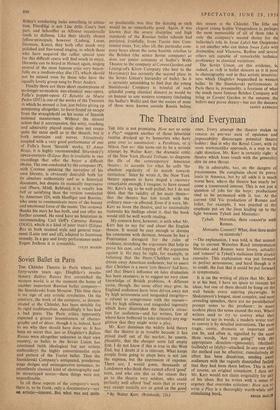Soviet Ballet in Paris
THE Chfltelet Theatre in Paris where, just forty-seven years ago, Diaghilev's revolu- tionary Ballets Russes first astonished the western world, is at the moment the home of another important Russian bullet company— the Stanislayski from Moscow. This time there is no sign of any artistic revolution. On the contrary, the work of the company, as demon- strated at the Chatelet, has been notable for its rigid traditionalism, Accordingly it has had a bad press. The Paris critics apparently expected a greater inventiveness of choreo- graphy and of decor, though it is, indeed, hard to see why they should have done so. It has. been no secret that, just as Diaghilev's Ballets Russes were altogether unknown in their own country, so ballet in the Soviet Union has continued (with idealogical but not artistic embroidery) the highly conventionalist style and pattern of the Tsarist ballet. Thus the Stanislayski Company's antiquated, ponderous stage designs and unimaginative costumes, its relentlessly classical kind of choreography and its stereotyped scores—these things were not unpredictable.
In all these aspects of the company's work there is, to be frank, only 'a documentary—not an artistic—interest. But what was not quite
so predictable was that the dancing as such would be so remarkably good. Again, it was known that the severe discipline and high standards of the Russian ballet schools had persisted, fruitfully, from Tsarist into Com- munist times. Yet, after all, this particular com- pany bears about the same humble relation to the Bolshoi (the senior Soviet company) as does our junior company at Sadler's Wells Theatre to the company at Covent Garden; and Leningrad's. Kirov Company (the heir to the Maryinsky) has certainly the second place in the Soviet Union's hierarchy of ballet. So it is certainly astonishing to find that the young Stanislayski Company is brimful of such splendid young classical dancers as would be an honour to any western company (including the Sadler's Wells) and that the names of none of these were known outside Russia before this season at the Chatelet. The lithe an• elegant young Sophie Vinagradova is, perhap. the most memorable of all of them (she I• only the company's second choice for th ballerina's role in Swan Lake) but Ossipienk is yet another who can dance Swan Lake wit distinction, and Vlassova, Redina and severa others are capable of remarkable technica proficiency in classical variations.
The Soviet Union, on this evidence, is indeed, us rich in ballet dancers as it is poo in choreography and in that artistic inventive ness which Diaghilev bequeathed to wester ballet. In the Stanislayski performances i Paris there is, presumably, a foretaste of wha the much more famous Bolshoi Company wil bring to Covent Garden in the autumn; th ballets may prove dreary—but not the dancers
JAMES KENNED


































 Previous page
Previous page